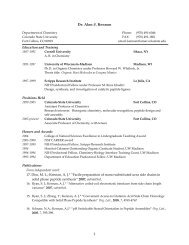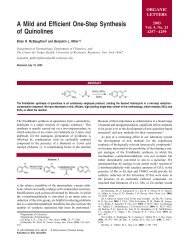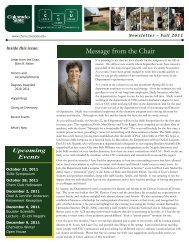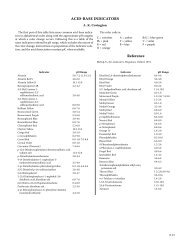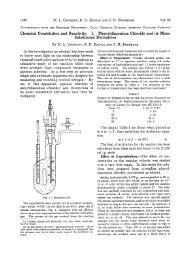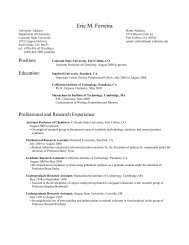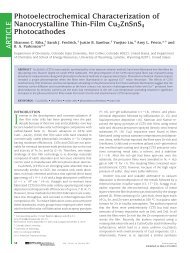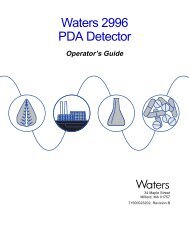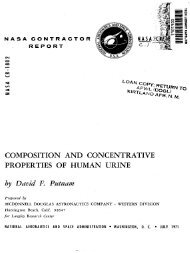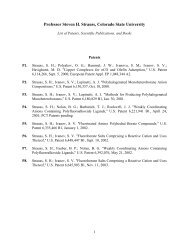(SrTiO3) as an anode material for lithium-ion batteries
(SrTiO3) as an anode material for lithium-ion batteries
(SrTiO3) as an anode material for lithium-ion batteries
You also want an ePaper? Increase the reach of your titles
YUMPU automatically turns print PDFs into web optimized ePapers that Google loves.
D.C. Johnson, A.L. Prieto / Journal of Power Sources 196 (2011) 7736– 7741 7737<br />
Fig. 1. React<strong>ion</strong> scheme <strong>for</strong> the co-precipitat<strong>ion</strong>/solvothermal synthesis of <strong>SrTiO3</strong> n<strong>an</strong>oparticles <strong>an</strong>d subsequent photoinduced reduct<strong>ion</strong> of chloroplatinic acid on the <strong>SrTiO3</strong><br />
n<strong>an</strong>oparticle surface.<br />
<strong>for</strong> which the react<strong>ion</strong> mech<strong>an</strong>ism is contained in Fig. 1 [8]. Using<br />
st<strong>an</strong>dard Schlenk line techniques, two solut<strong>ion</strong>s, a 5% TiCl 4 (99.9%,<br />
Aldrich) in ethyl alcohol (200 proof ACS grade, Pharmco-Aaper) <strong>an</strong>d<br />
a 0.2 M Sr(OH) 2·8H 2O (95%, Aldrich) in 1 M acetic acid (aq.) (ACS,<br />
Mallinckrodt chemicals), were prepared. While vigorously stirring,<br />
the solut<strong>ion</strong>s were combined. The resulting white slurry w<strong>as</strong> tr<strong>an</strong>sferred<br />
to a 23 mL PTFE lined acid digest<strong>ion</strong> vessel (Parr, 4749).<br />
The vessel w<strong>as</strong> heated at 4 ◦ C min −1 to 240 ◦ C <strong>an</strong>d held <strong>for</strong> 12 h.<br />
The resulting product w<strong>as</strong> centrifuged, dec<strong>an</strong>ted, <strong>an</strong>d sonicated in<br />
Millipore ® water at le<strong>as</strong>t three times to separate the n<strong>an</strong>oparticles<br />
from react<strong>ion</strong> byproducts. The n<strong>an</strong>oparticles were platinized<br />
by irradiating at 254 nm in the presence of H 2PtCl 6 (99.995%,<br />
Aldrich), methyl alcohol (99.9%, Sigma Aldrich), <strong>an</strong>d Millipore ®<br />
water similarly to that reported in the literature [9–11]. React<strong>ion</strong><br />
byproducts were removed using the same procedure <strong>as</strong> described<br />
above.<br />
2.2. N<strong>an</strong>oparticle characterizat<strong>ion</strong><br />
The n<strong>an</strong>oparticles were characterized by tr<strong>an</strong>smiss<strong>ion</strong> electron<br />
microscopy (TEM), selected-area electron diffract<strong>ion</strong> (SAED), powder<br />
X-ray diffract<strong>ion</strong> (XRD), <strong>an</strong>d X-ray photoelectron spectroscopy<br />
(XPS). TEM images were obtained using a JEOL JEM-2000 tr<strong>an</strong>smiss<strong>ion</strong><br />
electron microscope operating under <strong>an</strong> accelerating voltage<br />
of 160 kV. Powder XRD patterns were collected on a Scintag X-<br />
2 Adv<strong>an</strong>ced Diffract<strong>ion</strong> System equipped with Cu K radiat<strong>ion</strong><br />
with a wavelength of 1.54 nm. XPS spectra were obtained using<br />
a Physical Electronics ESCA 5800 system employing monochromatic<br />
Al K (E = 1486.6 eV) <strong>as</strong> the X-ray source. High resolut<strong>ion</strong><br />
sc<strong>an</strong>s were utilized to confirm the presence <strong>an</strong>d provide in<strong>for</strong>mat<strong>ion</strong><br />
regarding the bonding environment <strong>an</strong>d oxidat<strong>ion</strong> state of Sr,<br />
Ti, O, Pt, <strong>an</strong>d Cl. These sc<strong>an</strong>s were per<strong>for</strong>med with a p<strong>as</strong>s energy of<br />
23.5 eV <strong>an</strong>d a step size of 0.10 eV step −1 . All spectra were shifted to<br />
Fig. 2. (a) Characteristic TEM image of synthesized <strong>SrTiO3</strong> n<strong>an</strong>oparticles with (b) corresponding indexed SAED pattern. (c) Higher magnificat<strong>ion</strong> TEM image illustrating the<br />
cubic morphology.




